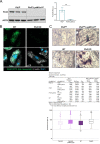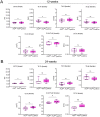Osteoclast-specific Plastin 3 knockout in mice fail to develop osteoporosis despite dramatic increased osteoclast resorption activity
- PMID: 38549711
- PMCID: PMC10971598
- DOI: 10.1093/jbmrpl/ziad009
Osteoclast-specific Plastin 3 knockout in mice fail to develop osteoporosis despite dramatic increased osteoclast resorption activity
Abstract
PLS3 loss-of-function mutations in humans and mice cause X-linked primary osteoporosis. However, it remains largely unknown how PLS3 mutations cause osteoporosis and which function PLS3 plays in bone homeostasis. A recent study showed that ubiquitous Pls3 KO in mice results in osteoporosis. Mainly osteoclasts were impacted in their function However, it has not been proven if osteoclasts are the major cell type affected and responsible for osteoporosis development in ubiquitous Pls3 KO mice. Here, we generated osteoclast-specific Pls3 KO mice. Additionally, we developed a novel polyclonal PLS3 antibody that showed specific PLS3 loss in immunofluorescence staining of osteoclasts in contrast to previously available antibodies against PLS3, which failed to show PLS3 specificity in mouse cells. Moreover, we demonstrate that osteoclast-specific Pls3 KO causes dramatic increase in resorptive activity of osteoclasts in vitro. Despite these findings, osteoclast-specific Pls3 KO in vivo failed to cause any osteoporotic phenotype in mice as proven by micro-CT and three-point bending test. This demonstrates that the pathomechanism of PLS3-associated osteoporosis is highly complex and cannot be reproduced in a system singularly focused on one cell type. Thus, the loss of PLS3 in alternative bone cell types might contributes to the osteoporosis phenotype in ubiquitous Pls3 KO mice.
Keywords: Plastin 3; bone resorption; genetic animal model; osteoclasts; osteoporosis.
© The Author(s) 2024. Published by Oxford University Press on behalf of the American Society for Bone and Mineral Research.
Conflict of interest statement
There are no related or potential conflicts of interest.
Figures




Similar articles
-
Plastin 3 influences bone homeostasis through regulation of osteoclast activity.Hum Mol Genet. 2018 Dec 15;27(24):4249-4262. doi: 10.1093/hmg/ddy318. Hum Mol Genet. 2018. PMID: 30204862
-
Plastin 3 in health and disease: a matter of balance.Cell Mol Life Sci. 2021 Jul;78(13):5275-5301. doi: 10.1007/s00018-021-03843-5. Epub 2021 May 23. Cell Mol Life Sci. 2021. PMID: 34023917 Free PMC article. Review.
-
Mice lacking plastin-3 display a specific defect of cortical bone acquisition.Bone. 2020 Jan;130:115062. doi: 10.1016/j.bone.2019.115062. Epub 2019 Oct 31. Bone. 2020. PMID: 31678489
-
A novel splice mutation in PLS3 causes X-linked early onset low-turnover osteoporosis.J Bone Miner Res. 2015 Mar;30(3):510-8. doi: 10.1002/jbmr.2355. J Bone Miner Res. 2015. PMID: 25209159
-
The intricate mechanism of PLS3 in bone homeostasis and disease.Front Endocrinol (Lausanne). 2023 Jul 7;14:1168306. doi: 10.3389/fendo.2023.1168306. eCollection 2023. Front Endocrinol (Lausanne). 2023. PMID: 37484945 Free PMC article. Review.
Cited by
-
Functional Insights in PLS3-Mediated Osteogenic Regulation.Cells. 2024 Sep 9;13(17):1507. doi: 10.3390/cells13171507. Cells. 2024. PMID: 39273077 Free PMC article.
References
LinkOut - more resources
Full Text Sources
Molecular Biology Databases
Research Materials

